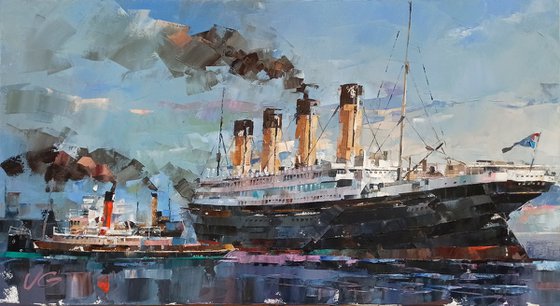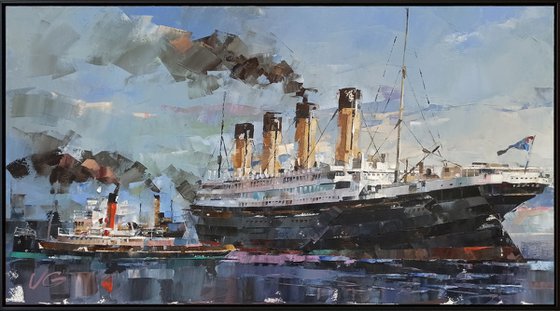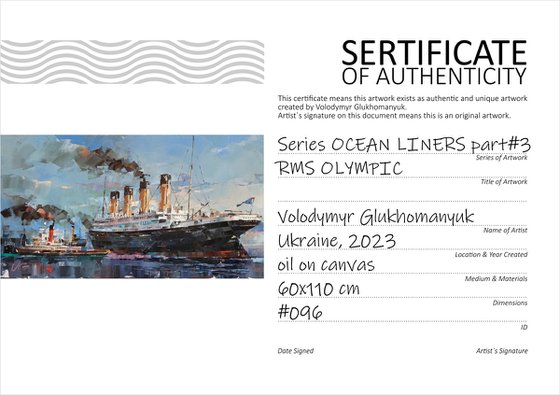Main Navigation
Original artwork description:
RMS OLYMPIC is a transatlantic liner of the White Star Line company, the first of a series of three Olympic-class liners. The other two ships were the Titanic and the Britannic.
The keel of "Olympic" was laid in December 1908, and "Olympic" was launched on October 20, 1910. The body of the liner was painted white to look better in the photo, because "Olympic" was the main element in the advertising campaign. After launching, the hull was repainted black.
The world was shocked after the death of the "unsinkable" Titanic, and if one "unsinkable" sank, the second would also sink. The sailors began to strike: they did not want to go on a voyage on a dangerous ship with insufficient number of boats. Therefore, waterproof bulkheads were raised to deck B, and the number of lifeboats was also increased: from 20 to 64. Only after those changes did the sailors again agree to go to sea on the "Olympic".
During the First World War, "Olympic" served as military transport. On May 12, 1918, "Olympic", accompanied by 4 destroyers, met the German submarine U-103. U-103, being on the surface, launched 3 torpedoes at the ship, but the ship evaded two, and the third sunk without reaching the target. Then the "Olympic", not having serious weapons on board, swam to the submarine and sank it with a ram.
After decommissioning in 1935, many elements from the decoration of the "Olympic" were used in the "White Swan" hotel. They were taken as an image by cinematographers when creating scenery for the filming of the movie "Titanic".
Materials used:
oil on canvas, palette knife
Tags:
#ocean painting #titanic 100th #steam ship #antique ship #ship oil #rms olympic #home décor #cargo ship #britannic #coastal shipRMS OLYMPIC (2023) Oil painting
by Volodymyr Glukhomanyuk
£2,310.75 Sold
- Oil painting on Canvas
- One of a kind artwork
- Size: 110 x 60 x 2cm (unframed) / 110 x 60cm (actual image size)
- Ready to hang
- Signed certificate of authenticity
- Style: Impressionistic
- Subject: Landscapes, sea and sky
Do you like this artwork?
This artwork has sold, but the artist is accepting commission requests. Commissioning an artwork is easy and you get a perfectly personalised piece.
Loading
Original artwork description
RMS OLYMPIC is a transatlantic liner of the White Star Line company, the first of a series of three Olympic-class liners. The other two ships were the Titanic and the Britannic.
The keel of "Olympic" was laid in December 1908, and "Olympic" was launched on October 20, 1910. The body of the liner was painted white to look better in the photo, because "Olympic" was the main element in the advertising campaign. After launching, the hull was repainted black.
The world was shocked after the death of the "unsinkable" Titanic, and if one "unsinkable" sank, the second would also sink. The sailors began to strike: they did not want to go on a voyage on a dangerous ship with insufficient number of boats. Therefore, waterproof bulkheads were raised to deck B, and the number of lifeboats was also increased: from 20 to 64. Only after those changes did the sailors again agree to go to sea on the "Olympic".
During the First World War, "Olympic" served as military transport. On May 12, 1918, "Olympic", accompanied by 4 destroyers, met the German submarine U-103. U-103, being on the surface, launched 3 torpedoes at the ship, but the ship evaded two, and the third sunk without reaching the target. Then the "Olympic", not having serious weapons on board, swam to the submarine and sank it with a ram.
After decommissioning in 1935, many elements from the decoration of the "Olympic" were used in the "White Swan" hotel. They were taken as an image by cinematographers when creating scenery for the filming of the movie "Titanic".
Materials used:
oil on canvas, palette knife
Tags:
#ocean painting #titanic 100th #steam ship #antique ship #ship oil #rms olympic #home décor #cargo ship #britannic #coastal ship14 day money back guaranteeLearn more










